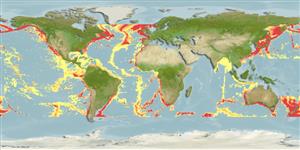Common names from other countries
>
Notacanthiformes (Halosaurs and deep-sea spiny eels) >
Notacanthidae (Deep-sea spiny eels)
Etymology: Notacanthus: Greek, noton = back + Greek, akantha = thorn (Ref. 45335).
More on author: Bloch.
Issue
Species spelling Paxton et al. 1989 (Ref.7300:150).
Environment: milieu / climate zone / depth range / distribution range
นิเวศวิทยา
เกี่ยวกับทะเล,น้ำเค็ม กลุ่มสัตว์หน้าดิน,กลุ่มสัตว์พื้นท้องน้ำ; ระดับความลึก 125 - 3285 m (Ref. 58426), usually 128 - 1000 m (Ref. 117245). Deep-water; 61°N - 50°S, 180°W - 180°E
Worldwide except in tropical waters (Ref. 27363). North Atlantic: Gulf of Mexico and Cape Blanc, Mauritania north to Davis Strait, Canada and Iceland. South Atlantic: off South Africa. Southeast Pacific: off Chile. Eastern Indian Ocean: Australia (Ref. 7300). Southwest Pacific: New Zealand (Ref. 5755).
ขนาด / น้ำหนัก / Age
Maturity: Lm ? range ? - ? cm
Max length : 120 cm TL เพศผู้/กระเทย; (Ref. 4449)
เงี่ยงครีบหลัง (รวม) : 5 - 12; ก้านครีบอ่อนที่หาง (รวม) : 2; เงี่ยงครีบก้น: 14 - 17; ก้านครีบอ่อนที่ก้น: 125 - 145; สัตว์มีกระดูกสันหลัง: 225 - 239. Presence of palatine and dentary teeth in two or more rows. Numerous dorsal spines. Small specimens are pale tan or pale bluish gray, large specimens are dark brown (Ref. 37108).
Benthopelagic (Ref. 58302) and epibenthic (Ref. 58426). Not uncommon in depths around 180 m off Iceland and Greenland. Individuals with nearly ripe eggs have been found in late autumn off Iceland. Mostly found at depths well below 200 m, but enters slightly shallower water on Grand Banks in Canada (Ref. 7251). Feeds primarily on sea anemones (Ref. 4449).
Life cycle and mating behavior
Maturities | การสืบพันธุ์ | Spawnings | Egg(s) | Fecundities | ตัวอ่อน
Sulak, K.J., 1990. Notacanthidae. p. 133-135. In J.C. Quero, J.C. Hureau, C. Karrer, A. Post and L. Saldanha (eds.) Check-list of the fishes of the eastern tropical Atlantic (CLOFETA). JNICT, Lisbon; SEI, Paris; and UNESCO, Paris. Vol. 1. (Ref. 4449)
IUCN Red List Status (Ref. 130435)
CITES (Ref. 128078)
Not Evaluated
Threat to humans
Harmless
Human uses
การประมง: ไม่มีผลประโยชน์
เครื่องมือ
Special reports
Download XML
แหล่งที่มาจากอินเตอร์เน็ต
Estimates based on models
Preferred temperature (Ref.
115969): 1 - 14.9, mean 6.1 (based on 2531 cells).
Phylogenetic diversity index (Ref.
82804): PD
50 = 0.5161 [Uniqueness, from 0.5 = low to 2.0 = high].
Bayesian length-weight: a=0.00191 (0.00103 - 0.00352), b=3.07 (2.90 - 3.24), in cm Total Length, based on LWR estimates for this species & (Sub)family-body (Ref.
93245).
ระดับชั้นอาหาร (Ref.
69278): 3.5 ±0.37 se; based on food items.
ความสามารถในการกลับคืนสู่ปกติ (Ref.
120179): ต่ำ, เวลาต่ำสุดที่จะทำให้ประชากรเพิ่มขึ้นเป็น 2 เท่าใช้เวลา 4.5 - 14 ปี (Assuming tmax>10).
Fishing Vulnerability (Ref.
59153): High to very high vulnerability (69 of 100).
